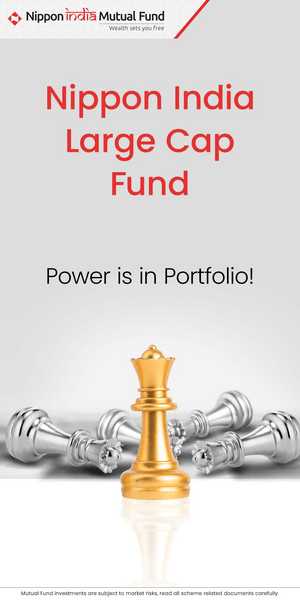Importance of having exposure to commodities in the portfolio

Asset allocation refers to the diversification of your investment portfolio across different types of assets. A 1986 study done in the United States showed that asset allocation is the most important determinant of portfolio performance (source: Brinson, Hood, Beebower, Financial Analyst Journal 1986). Equity and fixed income are the traditional asset classes for retail investors. Commodity is also an important asset class for institutional investors and HNIs. Commodities are natural resources which can be used as raw material to create different products. Examples of commodities are precious metals or bullion (e.g. gold, silver), base metals (e.g. aluminium, copper, zinc etc), energy (e.g. crude oil, natural gas etc), agro products (e.g. wheat, rice, sugar etc). In this article, we will focus on precious metals or bullion as commodities.
Commodities - Hedge against inflation
While low to moderate rates of inflation is usually good for equities, high inflation has a negative impact because consumers cut down on spending in high inflation environment. Companies which do not have pricing power are forced to reduce price and take a hit on profit margins. Commodities, on the other hand, give higher returns as inflation rises because rising commodity prices is one of the main causes of inflation. From ancient times, precious metals like gold retained their purchasing power over time. That is why precious metals are considered stores of economic value or hedge against inflation. In the chart below, we have plotted CPI inflation over the last 12 years versus Gold and Silver Returns. You can see that gold and silver as an asset class have generated inflation beating returns in most years. You should have precious metals in your asset allocation to protect your portfolio against inflation without adding too much volatility.

Source: World Bank, MCX, as on 31st December 2023. Disclaimer: Past performance may or may not be sustained in the future. The chart above is purely for investor education purposes and not for asset allocation recommendation
Precious metals have low or negative correlation with equities
There is low correlation between returns of different asset classes in different market conditions; equity and gold are usually counter-cyclical to each other i.e. gold outperforms when equity underperforms and vice versa (see the chart below). The reason for counter-cyclical nature of Gold is that the precious metals are seen as safe haven assets; when the economic outlook worsens, investors turn to Gold for safety. Asset Allocation in precious metals will reduce portfolio volatility and provide you a more stable investment experience viz. if equity underperforms, then the outperformance of precious metals or vice versa will balance the risks.
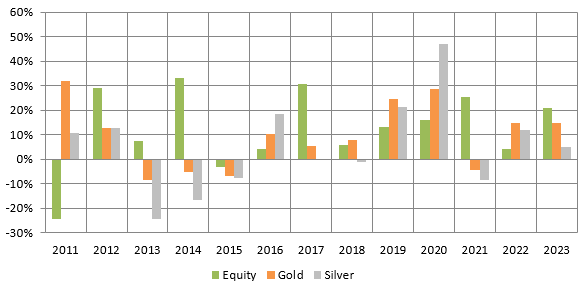
Source: NSE, MCX, as on 31st December 2023. Nifty 50 TRI has been used a proxy for equity as an asset class. Disclaimer: Past performance may or may not be sustained in the future. The chart above is purely for investor education purposes and not for asset allocation recommendation.
Suggested reading: Invest in Gold and Silver like a Pro: Diversify your portfolio
Precious metals have low correlation with fixed income
Fixed income has much lower volatility compared to equities. In the chart below we have shown the returns of fixed income investments versus returns of precious metals (gold and silver) over the last 12 years. You can see that gold and silver outperformed fixed income most of time, and fixed income outperformed when the precious metals underperformed.
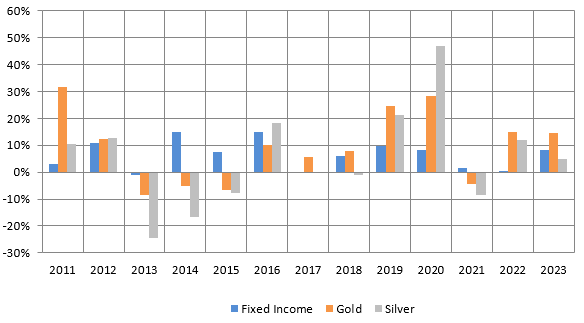
Source: NSE, MCX, as on 31st December 2023. Nifty 10 year Benchmark G-Sec index has been used a proxy for fixed income as an asset class. Disclaimer: Past performance may or may not be sustained in the future. The chart above is purely for investor education purposes and not for asset allocation recommendation
Why add Silver to your portfolio?
The price movement of Gold and Silver are similar in different investment cycles. However, Silver tends to outperform Gold in equity bull markets, especially in the early stages of economic recovery. Hence it can add further diversification to the asset allocation in your investment portfolio.
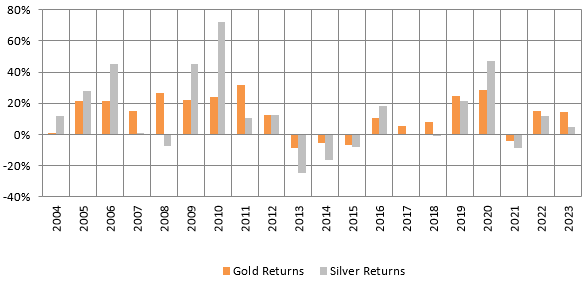
Source: MCX, as on 31st December 2023. Disclaimer: Past performance may or may not be sustained in the future. The chart above is purely for investor education purposes and not for asset allocation recommendation
Furthermore, unlike Gold, Silver has industrial use. Silver is used in new age industries e.g. solar panels, electric vehicles, smartphones, advanced electronics etc. With the growth of these new age industries, silver demand for industrial use is expected to rise significantly in the future. Though industrial demand is rising, the supply of silver is relatively constrained. Therefore, there is considerable scope of higher returns on investment from silver in the long term.
Is this a good time to invest in precious metals like Gold?
In the last 3 years gold has climbed from Rs 45,000 – 46,000 (per 10 grams) levels to Rs 62,000 – 63,000 (per 10 grams) levels growing at a CAGR of 11% (as on 29th February 2024, source: MCX). Are there further legs to the rally in gold? It is important for commodities investors to understand the relationship of gold and interest rates. The international price of gold also has an inverse relationship with US interest rates, i.e. price of gold generally stagnates or drops when interest rates rise and rises when interest rates fall. The chart below shows the international price of Gold (in USD per Troy ounce) versus the 10 year US Treasury Bond yield over the last 20 years. You can see that the gold prices rallied when the 10 year Treasury Bond yield fell and stagnated / declined when Treasury Bond yields bottomed out and started rising again.
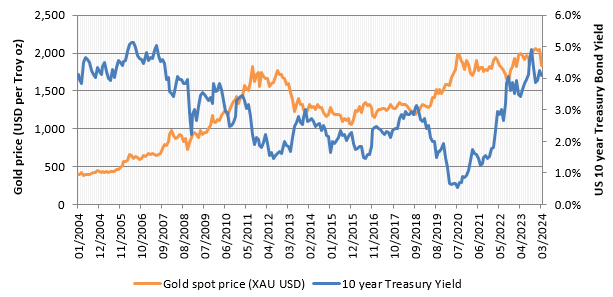
Source: Investing.com, as on 31st December 2023. Disclaimer: Past performance may or may not be sustained in the future. The chart above is purely for investor education purposes and not for asset allocation recommendation
How can we explain this? Both US Treasury Bonds and gold are seen as safe assets. If US Treasury Bond yields or interest rates are high, then risk-averse investors prefer to invest in US Treasury Bonds. However, if Treasury bond yields start falling then gold becomes attractive to investors.
Related read why should one consider gold as a part of portfolio considering their prices in the current situation?
What is the outlook?
In its FOMC meeting in December 2023 the US Federal Reserve indicated that it will not raise interest rates any further and will cut interest rates multiple times in 2024. The US 10 year Treasury bond yield has fallen from its 15 year high of more than 5% to around 4% by February 2023 in anticipation of rate cuts. US bond yields are likely to fall further as rate cuts draw nearer and may continue to fall when Fed starts cutting interest rates. Lower US bond yields will provide further legs to the rally in gold prices in the medium term. In the long term, gold as an asset class, is a hedge against inflation and therefore may provide inflation adjusted returns to investors. Over the last 20 years, gold in INR terms has given 12% CAGR returns (source: MCX, as on 29th February 2024).
How to invest in precious metals?
Indian families have been buying Gold and Silver in physical form since the ancient times; it is part of our cultural tradition. However gold and silver jewellery or other articles usually have impurities. Physical gold and silver includes storage charges e.g. bank locker fees. For financial investments, gold and silver exchange traded funds (ETFs) are much more suitable options. In gold or silver ETFs, there are no impurities or making charges; you get the value of pure gold or silver. Gold and silver ETFs are much more liquid than physical gold or silver jewellery or other articles. Gold and silver ETFs can be sold in the stock exchanges on any trading session at prevailing rates / prices.
You may also like to read why should commodities be a part of your portfolio at all times?
Gold Exchange Traded Funds or Gold ETFs are financial instruments that track the price of pure Gold. Gold ETFs are backed by physical Gold. One Gold ETF unit is equal to 1 gram of gold and is backed by 99.5% pure physical gold bars (source: AMFI, Knowledge Centre, Gold ETFs).
Silver exchange traded fund or Silver ETFs are financial instruments which track the price of pure silver. These instruments invest in physical silver or silver related instruments. Physical Silver of 30 kg bars with fineness of 999 parts per thousand (or 99.9% purity) conforming to London Bullion Market Association (LBMA) Good Delivery Standards are only permitted by SEBI for silver ETFs (source: SEBI circular on Norms for Silver Exchange Traded Funds (Silver ETFs) and Gold Exchange Traded Funds (Gold ETFs) dated November 24, 2021).
You need to have Demat and trading accounts to invest in ETFs. If you do not have a demat account, you can open one with any depository participant (DP); check with your stockbroker. The stockbroker / DP will open a demat account after you submit your KYC documents (e.g. PAN, Aadhaar cards, photographs etc). Along with the demat account, the stockbroker will also open a trading account for you, so that you can buy / sell ETFs or other securities through that account.
If you do not have a demat account, then you can invest in gold or silver through gold or silver fund of funds (FOFs). Gold or silver FOFs are like any other open ended mutual fund scheme. You can purchase / redeem units of gold or silver FOFs with the Asset Management Company (AMC) at prevailing Net Asset Values (NAVs).
Mutual Fund Investments are subject to market risk, read all scheme related documents carefully.
RECOMMENDED READS
LATEST ARTICLES
- Two new promising smart beta funds: Nippon India Nifty 500 Low Volatility 50 and Nifty 500 Quality 50 Index Funds
- Going hybrid in the current environment
- Asset allocation is key to long term investing: Hybrid funds make a lot of sense in current market conditions
- Should you invest in momentum funds: Why momentum works in investing
- Nippon India Active Momentum Fund: Invest in winners
The information being provided under this section 'Investor Education' is for the sole purpose of creating awareness about Mutual Funds and for their understanding, in general. The views being expressed only constitute opinions and therefore cannot be considered as guidelines, recommendations or as a professional guide for the readers. Before making any investments, the readers are advised to seek independent professional advice, verify the contents in order to arrive at an informed investment decision.
Mutual Fund investments are subject to market risks, read all scheme related documents carefully.
Quick Links
Follow Nippon India MF
More About Nippon India MF
POST A QUERY



